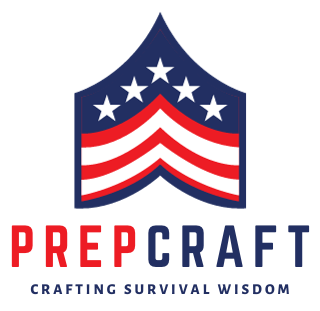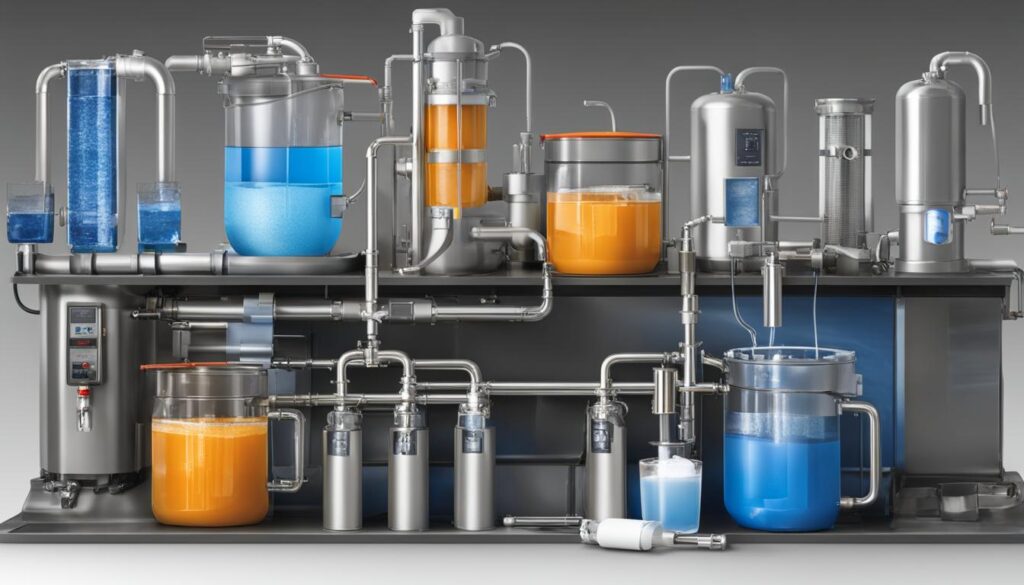
Disasters can strike unexpectedly, even while you’re on the road. That’s why it’s important to be prepared for any emergency that may occur. Vehicle preparedness is crucial for your safety and the safety of your loved ones. By turning your car into a mobile survival kit, you can ensure that you are ready to handle any situation that arises, whether it’s a roadside breakdown or a natural disaster.
Car survival kits, also known as vehicle emergency kits, are essential in maintaining car safety and emergency preparedness. These kits should contain a variety of supplies that can help you handle various emergencies, such as a flashlight, extra batteries, a first aid kit, emergency flares, a tire repair kit, water, and non-perishable food. Equipping your car with these necessary items will provide you with peace of mind and the ability to respond effectively in times of crisis.
Long trips require additional planning and preparation. When embarking on a journey, it’s important to plan ahead for potential disasters. This includes staying informed about weather forecasts and road conditions, keeping your gas tank full, and ensuring that your vehicle is in good working condition. Taking these precautions will help you avoid dangerous weather-related problems and ensure a safer trip.
During an earthquake situation, following safety tips is crucial for your protection. If an earthquake occurs while you’re driving, quickly move your car to the side of the road, away from hazardous structures or objects. Stay inside your vehicle until the shaking stops, and avoid driving through flooded areas, near downed power lines, or under damaged bridges.
After a disaster, it’s important to assess the damage to your vehicle and the immediate surroundings. If it’s safe to do so, proceed home or to a safe shelter, driving cautiously and staying updated with local radio stations for warnings and updates. Attend to any injuries and collaborate with others in the aftermath of the disaster to ensure everyone’s safety.
In addition to having a well-equipped car emergency kit, there are other tips you can follow to enhance your vehicle preparedness. Check your car insurance coverage for roadside assistance, keep emergency phone numbers in your cell phone, and stay informed about road conditions through resources like the National Safety Council or state-specific systems like 5-1-1. Being well-prepared will ensure that you can handle any situation that arises while on the road.
It’s not just important to be prepared in your car but also at your workplace. Having essential supplies and plans in place for emergencies is crucial. This includes a well-stocked first aid kit, emergency lighting, and a designated meeting place for office staff in case of evacuation. Personal supplies such as water, non-perishable food, and warm clothing should also be considered.
Communication and meeting plans are also essential for being fully prepared. Designate a meeting place for your family in case of a disaster, have essential contact information in your phone, and ensure you have a way to charge your phone in case of a power outage. Additionally, having emergency cash and personal hygiene supplies can further enhance your preparedness.
Key Takeaways:
- Vehicle preparedness is crucial for your safety while on the road.
- Car survival kits should contain essential supplies for emergencies.
- Planning ahead for long trips can help you avoid dangerous situations.
- Following safety guidelines during an earthquake while driving is essential.
- Assessing damage and proceeding safely after a disaster is important.
Remember, being prepared for emergencies can make a significant difference in the outcome of a crisis. By turning your car into a mobile survival kit and following the tips provided in this article, you can be confident in your ability to handle any situation on the road.
Car Emergency Kits: Essential Supplies for Preparedness
When it comes to vehicle preparedness, having a well-stocked car emergency kit is of utmost importance. This kit should contain essential supplies that can help you handle various emergencies that you may encounter while on the road. Being prepared with the right tools and resources can make all the difference in ensuring your safety and well-being.
Here are some essential supplies that should be included in your car emergency kit:
- Flashlight and extra batteries: A reliable light source is crucial during emergencies, especially when visibility is low.
- First aid kit: A comprehensive first aid kit will provide you with the necessary tools and materials to treat minor injuries until professional help arrives.
- Emergency flares: These can be used to signal for help or alert other drivers of your presence in case of a breakdown or accident.
- Tire repair kit: Flat tires are a common occurrence on the road, so having a tire repair kit can help you patch up any punctures and get back on track.
- Water: Staying hydrated is crucial, especially during unexpected delays or emergencies.
- Non-perishable food: Pack some energy bars or non-perishable snacks to keep you nourished during extended periods of waiting or in case of unforeseen circumstances.
These essential supplies will ensure that you are ready to handle any situation that may arise while traveling. It’s important to regularly check and update your car emergency kit to make sure that all items are in good condition and not expired. By being prepared, you can have peace of mind knowing that you have the necessary tools to handle emergencies on the road.
Comparison of Car Emergency Kit Supplies
| Supply | Description | Importance |
|---|---|---|
| Flashlight and extra batteries | Provides reliable light source during emergencies with extra batteries for extended use | Crucial for visibility and safety |
| First aid kit | Includes essential tools and materials for treating minor injuries | Immediate medical assistance |
| Emergency flares | Used to signal for help or alert other drivers in case of breakdowns or accidents | Visibility for safety purposes |
| Tire repair kit | Enables the patching of punctures and re-inflating tires | Fixes flat tires and ensures mobility |
| Water | Provides hydration during unexpected delays or emergencies | Essential for survival |
| Non-perishable food | Energy bars or snacks for sustenance during extended waits or unforeseen circumstances | Provides nourishment during emergencies |
Ensuring that your car emergency kit is well-stocked with these essential supplies will provide you with the peace of mind and confidence to handle any emergency situation on the road. Remember to periodically check and replenish your supplies to ensure that you are always prepared.
Preparing for Disasters: Planning Ahead for Long Trips
When embarking on long trips, it is crucial to plan ahead and be fully prepared for potential disasters. By taking the necessary precautions, you can ensure a safer journey and minimize the risks involved. Here are some essential steps to consider:
-
Stay Informed: Before hitting the road, make sure to stay updated with the latest weather forecasts and road conditions along your route. This will help you anticipate any potential hazards or adverse conditions you might encounter. Keep an eye out for severe weather conditions or natural disasters that may affect your travel plans.
-
Gas Tank and Vehicle Maintenance: Always start your trip with a full tank of gas. This will not only prevent unnecessary stops but also ensure you have enough fuel in case of unforeseen circumstances, such as diverted routes or extended travel times. Additionally, ensure your vehicle is properly maintained and in good working condition to minimize the risk of breakdowns or mechanical issues along the way.
-
Car Emergency Kit: Prepare a well-stocked car emergency kit that includes essential supplies to handle various emergencies. This kit should include a flashlight, extra batteries, a first aid kit, emergency flares, a tire repair kit, non-perishable snacks, and ample drinking water. Having these items readily available can make a significant difference in critical situations.
-
Share Your Itinerary: Inform a trusted friend or family member about your travel plans and share your itinerary with them. This way, someone will be aware of your route and can act promptly in case you encounter any unexpected issues or fail to reach your destination within the expected timeframe.
-
Know Alternative Routes: Research and identify alternative routes to your destination. In the event of road closures or traffic congestion, having alternate paths in mind can save you time and potential frustration. Additionally, keep a physical map or have a reliable offline navigation app on hand as a backup in case of GPS signal loss.
By following these proactive measures, you can enhance your preparedness and ensure a smoother and safer journey. Remember, planning ahead is key to minimizing the impact of unexpected disasters during long trips.
| Preparation Steps for Long Trips: | Benefits |
|---|---|
| Stay informed about weather and road conditions | Avoid hazardous weather-related problems |
| Maintain a full gas tank and proper vehicle maintenance | Minimize risks of breakdowns and delays |
| Create a well-stocked car emergency kit | Quick response to emergencies |
| Share your itinerary with a trusted contact | Prompt assistance if needed |
| Know alternative routes to your destination | Overcome road closures and congestion |
Remember, being prepared is crucial when it comes to traveling long distances. Equip yourself with proper knowledge, tools, and plans to effectively handle potential disasters along the way.
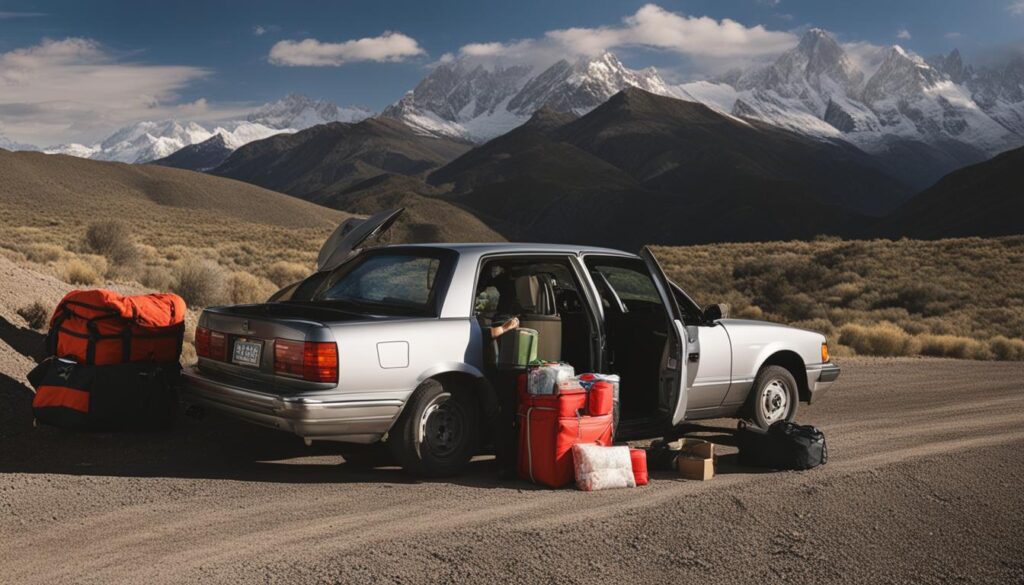
Safety Tips During a Disaster: Earthquake Situations
In the event of an earthquake while driving, following safety guidelines is crucial to protect yourself and ensure your safety. Here are some important safety tips to remember:
- Move to the side of the road: When you feel the earthquake, safely move your vehicle to the side of the road as quickly as possible. This will help minimize the risk of debris falling on your car or being in the path of potential hazards.
- Avoid parking near hazardous structures or objects: Choose a parking spot away from buildings, overpasses, bridges, or any other structures that could potentially collapse during the earthquake. Parking near trees, power lines, or street lights should also be avoided as they may pose a danger if they fall.
- Stay inside your vehicle: Once you have parked safely, stay inside your vehicle until the shaking stops. Your car provides a protective shelter, shielding you from flying debris or falling objects. Avoid getting out and seeking shelter elsewhere as you may be exposed to greater danger.
- Avoid driving through flooded areas: After an earthquake, flooding can occur due to damaged infrastructure. It is important to avoid driving through flooded areas as they may hide hazards beneath the water’s surface or compromise the stability of the road.
- Avoid driving near downed power lines or under damaged bridges: Downed power lines pose a severe electrical hazard, and damaged bridges may collapse. Stay alert and avoid driving near these high-risk areas.
By following these safety tips, you can significantly reduce the risks associated with earthquake situations while driving. Remember that your safety should always be the top priority during a disaster.
After a Disaster: Assessing Damage and Proceeding Safely
Once the shaking has stopped and it is safe to do so, I need to assess the damage to my vehicle and the immediate surroundings. This is crucial for determining the next steps in ensuring my safety and well-being after a disaster.
As I cautiously survey the area, it’s important to remain aware of any hazards that may still exist. Fallen power lines, structural damage, and other potential dangers should be avoided. I must prioritize my safety and the safety of others.
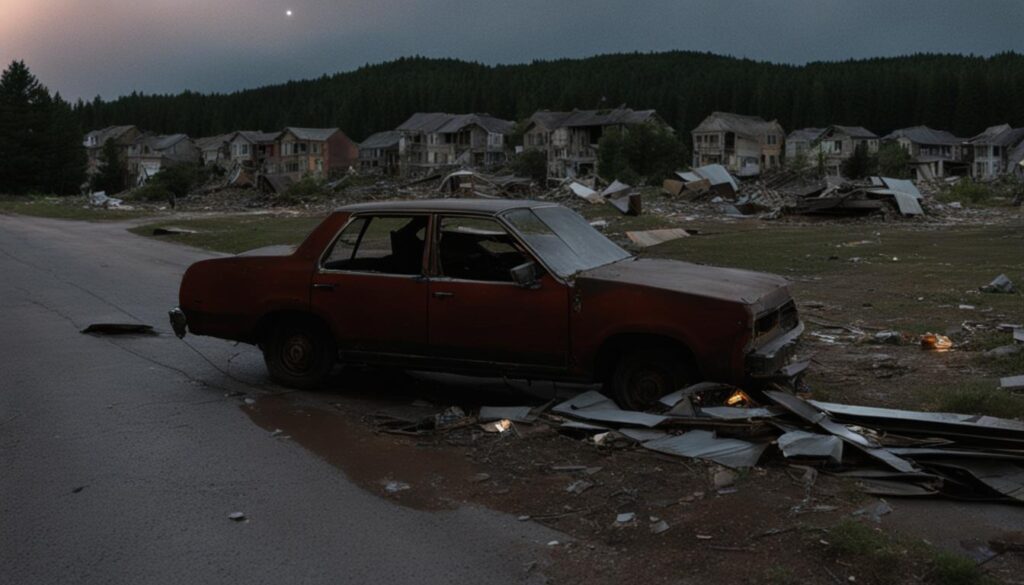
After assessing the damage, if my vehicle is still operable, I should proceed home or to a safe shelter. It is essential to drive carefully and attentively, keeping an eye out for road hazards and obeying any instructions or warnings from local authorities. Safety should be the top priority during the post-disaster journey.
Listening to Local Radio Stations
To stay informed about the latest updates and warnings, I’ll tune in to local radio stations. Radio broadcasts often provide critical information during and after a disaster, including road closures, alternative routes, and emergency services available in the area.
“Listening to local radio stations can provide important updates and guidance that can help me navigate the aftermath of a disaster safely.”
By staying tuned in, I can make informed decisions and adjust my route if necessary, ensuring that I reach my destination safely. It’s important to remember that conditions may change rapidly, so regular updates are essential.
Attending to Injuries and Working Together
Health and safety should always be prioritized after a disaster. If any injuries are sustained, it’s crucial to attend to them promptly. Basic first aid knowledge and a well-stocked first aid kit can be invaluable in these situations.
Additionally, working together with others in the aftermath of a disaster is essential. This may involve providing assistance to those in need, coordinating efforts with local authorities and organizations, or collaborating with fellow survivors to address immediate needs and ensure collective well-being.
I must approach the aftermath of a disaster with caution, compassion, and a focus on safety. By assessing the damage, proceeding safely, and attending to injuries and the needs of others, I can navigate the challenging post-disaster environment more effectively.
Vehicle Preparedness: Tips for Besides Car Emergency Kits
In addition to having a well-equipped car emergency kit, there are other tips that can enhance your vehicle preparedness. By taking a few extra precautions, you can ensure that you are ready to handle any situation that arises while on the road.
Check Your Car Insurance Coverage
One important tip is to check your car insurance coverage to see if it includes roadside assistance. In the event of a breakdown or emergency, having access to roadside assistance can provide you with the help you need, such as towing or jump-starting your vehicle.
Keep Emergency Phone Numbers Handy
Another useful tip is to keep a list of emergency phone numbers in your cell phone. This includes numbers for local police, fire departments, and towing services. Having these numbers readily available can save you valuable time during an emergency.
Stay Informed About Road Conditions
Staying informed about road conditions is essential for safe travel. Resources like the National Safety Council or state-specific systems like 5-1-1 provide real-time updates on road closures, traffic congestion, and weather conditions. By staying informed, you can plan your route accordingly and avoid potential hazards.
| Tips for Vehicle Preparedness |
|---|
| Check your car insurance coverage for roadside assistance |
| Keep a list of emergency phone numbers in your cell phone |
| Stay informed about road conditions through resources like the National Safety Council or state-specific systems like 5-1-1 |
By implementing these additional tips, you can enhance your vehicle preparedness and be better equipped to handle any unforeseen circumstances while on the road.
Workplace Emergency Preparedness: Essential Supplies and Plans
Being prepared for emergencies is not limited to your car; it is equally important to ensure workplace emergency preparedness. In this section, I will provide guidelines on the essential supplies and plans that should be in place at your workplace. By taking these measures, you can help protect your employees and minimize the impact of any emergency situation.
Essential Supplies
One of the key aspects of workplace emergency preparedness is having essential supplies readily available. Here are some items that should be included:
- First aid kit: A well-stocked first aid kit is crucial in addressing injuries and providing initial medical aid.
- Emergency lighting: In case of a power outage, having emergency lighting such as flashlights or battery-powered lanterns can help maintain visibility and prevent accidents.
Emergency Plans
Having well-thought-out plans in place is equally important as having adequate supplies. Here are some key emergency plans that should be established:
- Evacuation plan: A clear evacuation plan should be developed outlining escape routes, assembly areas, and procedures for different emergency scenarios.
- Communication plan: It is essential to establish a reliable communication plan to ensure effective and timely dissemination of information during an emergency. This may involve utilizing intercom systems, phone trees, or other methods.
Personal Supplies
While workplace emergency preparedness mainly focuses on the overall safety of the employees, it is also essential to consider individual needs. Encourage employees to keep personal supplies at their workstations, including:
- Water: Encourage employees to keep a supply of drinking water for their own needs.
- Non-perishable food: Having non-perishable food items, such as energy bars or canned goods, can provide sustenance during extended emergency situations.
- Warm clothing: In case of prolonged power outages or cold weather, having warm clothing readily available can help employees stay comfortable and prevent hypothermia.
Remember, workplace emergency preparedness is a shared responsibility. It is crucial to regularly review and update your emergency plans and supplies to ensure they remain effective and up-to-date.
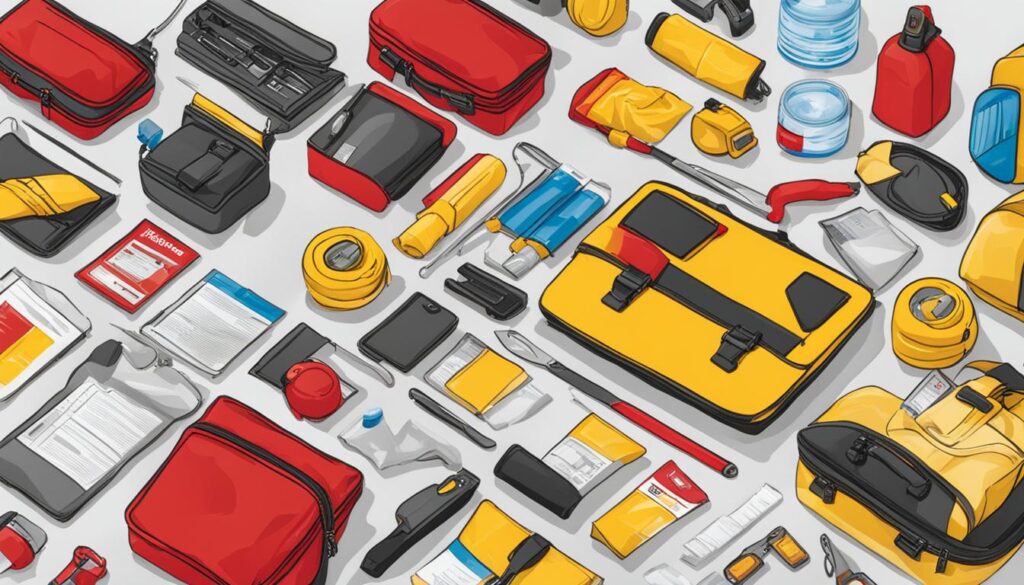
Additional Tips for Being Prepared: Communication and Meeting Plans
In order to be fully prepared for any emergency situation, it is essential to have effective communication and meeting plans in place. By establishing these plans, you can ensure that you and your family stay connected and informed during times of crisis.
Designate a Meeting Place
One important aspect of being prepared is designating a meeting place for your family in case you get separated during a disaster. Choose a location that is easily accessible and familiar to everyone. This meeting place should be a central location that is safe and easily identifiable. Make sure that all family members are aware of this designated meeting place, and discuss it regularly to reinforce the plan.
Have Essential Contact Information
It is crucial to have essential contact information readily available in case of an emergency. Store important phone numbers, such as your local emergency services, family members, and close friends in your phone’s contacts list. This will allow you to quickly reach out to them when needed. Additionally, consider creating a laminated card with important contact information that you can keep in your wallet or purse as a backup.
Ensure Phone Charging Capability
During an emergency, power outages are common. It is essential to ensure that you have a reliable way to charge your phone and keep it powered up. Invest in portable power banks or car chargers to ensure that your phone remains functional in case of an extended power outage. Keeping your phone charged will enable you to stay connected, receive important updates, and communicate with your loved ones.
Emergency Cash and Personal Hygiene Supplies
Aside from communication, it is also important to have emergency cash on hand. In the event that ATMs or banks are unavailable, having cash can be invaluable for purchasing essential supplies or securing transportation. Additionally, don’t forget to include personal hygiene supplies in your emergency kit, such as hand sanitizers, wet wipes, and toilet paper. These items will help ensure your comfort and cleanliness during challenging times.
By implementing these additional tips for being prepared, you can enhance your overall readiness for emergencies. Remember, effective communication and meeting plans, along with essential supplies, are vital for your safety and well-being during uncertain times.
| Contact Information | Meeting Place |
|---|---|
| Local Emergency Services: 911 | Central Park, Main Entrance |
| Closest Family Member: John Smith – 555-1234 | Fountain Square, Downtown |
| Close Friend: Emily Johnson – 555-5678 | City Hall, Near Flagpole |
Conclusion
Being prepared for emergencies while on the road is essential for your safety. By turning your car into a mobile survival kit and following the tips provided in this article, you can ensure that you are ready to handle any situation that may arise. Remember to regularly check and update your car emergency kit, stay informed about potential hazards, and take necessary precautions to protect yourself and your loved ones. Vehicle preparedness can make a significant difference in the outcome of an emergency situation.
Having a well-stocked car emergency kit, including essential supplies such as a flashlight, first aid kit, and emergency flares, is crucial for ensuring your preparedness. Additionally, planning ahead for long trips and staying informed about weather conditions and road conditions can help prevent dangerous situations. In the event of an earthquake or other disaster, following safety guidelines and assessing damage before proceeding can help keep you safe.
In addition to your car emergency kit, consider other tips for enhancing your vehicle preparedness, such as checking your car insurance coverage for roadside assistance and keeping emergency phone numbers in your cell phone. Workplace emergency preparedness is also important, with essential supplies and plans in place. Lastly, having communication and meeting plans, designated meeting places, and personal supplies can further enhance your overall preparedness.
Remember, being prepared is key. Regularly review and update your emergency kits, stay informed, and take necessary precautions. By prioritizing vehicle and workplace preparedness, you can ensure your safety and the safety of those around you in times of emergencies.
FAQ
What should be included in a car emergency kit?
A car emergency kit should include items such as a flashlight, extra batteries, first aid kit, emergency flares, tire repair kit, water, and non-perishable food.
How should I prepare for disasters during long trips?
To prepare for disasters during long trips, you should listen to the latest weather forecasts and road conditions, keep your gas tank full, and maintain your vehicle in good working condition.
What safety tips should I follow during an earthquake while driving?
During an earthquake while driving, it is important to move to the side of the road as quickly as possible, avoid parking near hazardous structures or objects, and stay inside your vehicle until the shaking stops.
What should I do after a disaster while on the road?
After a disaster while on the road, you should assess the damage to your vehicle and immediate surroundings. If it is safe to do so, proceed home or to a safe shelter, driving cautiously and listening to local radio stations for warnings and updates.
What are some additional tips for vehicle preparedness?
Some additional tips for vehicle preparedness include checking your car insurance coverage for roadside assistance, keeping emergency phone numbers in your cell phone, and staying informed about road conditions through resources like the National Safety Council or state-specific systems.
How should I prepare for emergencies at my workplace?
To prepare for emergencies at your workplace, you should have a well-stocked first aid kit, emergency lighting, a designated meeting place for office staff in case of evacuation, and personal supplies such as water, non-perishable food, and warm clothing.
What should I include in my communication and meeting plans for emergencies?
In your communication and meeting plans, you should designate a meeting place for your family in case of a disaster, have essential contact information in your phone, ensure you have a way to charge your phone in case of a power outage, and consider having emergency cash and personal hygiene supplies.
